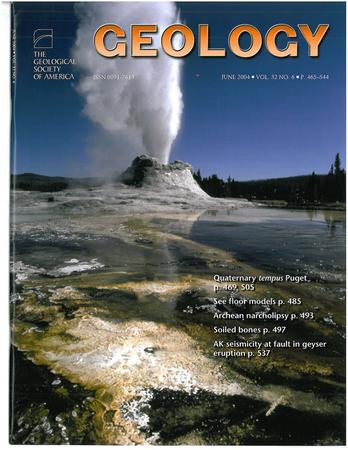超高压大理岩中锌同位素揭示的大陆俯冲带碳守恒
IF 4.6
1区 地球科学
Q1 GEOLOGY
引用次数: 0
摘要
在地质时期,碳通过俯冲作用从地球表面转移到内部,调节了大气中的二氧化碳浓度。然而,与海洋俯冲带相比,大陆俯冲带的碳转移效率却鲜为人知。锌同位素是碳酸盐溶解的敏感指标,含c流体优先含重锌。对大陆俯冲形成的大别-苏鲁造山带超高压大理岩锌同位素进行了研究。与沉积原岩相比,方解石大理岩中锌浓度和同位素比值的耦合下降为溶蚀作用提供了直接证据,但方解石碳酸盐的溶蚀作用总体上几乎可以忽略不计。对于白云石大理岩,锌浓度升高和锌同位素比值降低表明溶解的碳酸盐在板内发生了强烈的再固定。这些发现共同表明,碳酸盐岩在大陆地壳俯冲和随后的挖掘过程中表现出保存行为。大陆地壳中绝大多数(>98%)的碳最终储存在被挖出的板块中,这表明大陆俯冲系统中的碳收支接近平衡,对全球碳通量的影响有限。相反,海洋俯冲带在地球外部和内部的碳转移中起着至关重要的作用。本文章由计算机程序翻译,如有差异,请以英文原文为准。
Carbon conservation in continental subduction zones revealed by zinc isotopes in ultrahigh-pressure marbles
Transfer of carbon from Earth’s surface into the interior via subduction regulates atmospheric CO2 concentrations over geologic time. The transfer efficiency of carbon in continental subduction zones, however, is less known than that in oceanic subduction zones. Zinc isotopes are a sensitive proxy of carbonate dissolution, with C-bearing fluids preferentially incorporating heavy zinc. We investigate zinc isotopes in ultrahigh-pressure marbles from the Dabie-Sulu orogenic belt formed via continental subduction. Coupled declines of zinc concentrations and isotope ratios in calcite marbles compared with their sedimentary protoliths provide direct evidence for dissolution, but the dissolution fraction of calcite carbonates, as a whole, is almost negligible. For dolomite marbles, the elevated zinc concentrations and decreased zinc isotope ratios indicate that dissolved carbonates underwent strong refixation within the slab. These findings collectively demonstrate that carbonates exhibit conservation behaviors during continental crust subduction and consequent exhumation. The vast majority (>98%) of carbon in continental crust is ultimately stored in the exhumed slabs, indicating that the carbon budget in continental subduction systems is nearly balanced and has limited impact on the global carbon flux. Instead, oceanic subduction zones play an essential role in carbon transfer between Earth’s exterior and interior.
求助全文
通过发布文献求助,成功后即可免费获取论文全文。
去求助
来源期刊

Geology
地学-地质学
CiteScore
10.00
自引率
3.40%
发文量
228
审稿时长
6.2 months
期刊介绍:
Published since 1973, Geology features rapid publication of about 23 refereed short (four-page) papers each month. Articles cover all earth-science disciplines and include new investigations and provocative topics. Professional geologists and university-level students in the earth sciences use this widely read journal to keep up with scientific research trends. The online forum section facilitates author-reader dialog. Includes color and occasional large-format illustrations on oversized loose inserts.
 求助内容:
求助内容: 应助结果提醒方式:
应助结果提醒方式:


